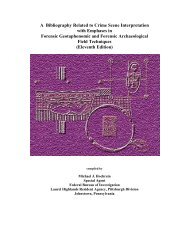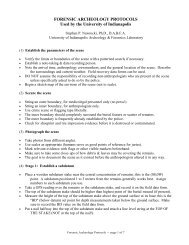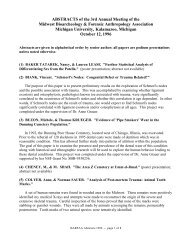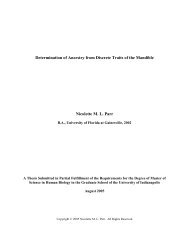Abstracts - University of Indianapolis Archeology & Forensics ...
Abstracts - University of Indianapolis Archeology & Forensics ...
Abstracts - University of Indianapolis Archeology & Forensics ...
You also want an ePaper? Increase the reach of your titles
YUMPU automatically turns print PDFs into web optimized ePapers that Google loves.
paleopathology but rather can give quite valuable information about the social environment and<br />
attitudes at the time period being examined regardless <strong>of</strong> sample size.<br />
(21) PLOCHOCKI, J.H. "Estimation <strong>of</strong> Sex from the Adult Human Sacrum." (poster<br />
presentation)<br />
An important component <strong>of</strong> forensic investigations involving human skeletal material is the<br />
estimation <strong>of</strong> sex. The sacrum, although not as reliable as the os coxae and cranium, can provide<br />
information concerning the sex <strong>of</strong> an individual in situations where other skeletal elements are<br />
damaged or absent, or where remains are commingled. Several methods <strong>of</strong> sex estimation from the<br />
sacrum have been developed, however these methods require race to be known. Additionally, most <strong>of</strong><br />
these methods rely on more than five measurements, which may be difficult to apply to fragmentary<br />
sacra. The present study generates a discriminant function for sex estimation from five measurements<br />
<strong>of</strong> the sacrum without prior knowledge <strong>of</strong> race. The sample in this analysis was comprised <strong>of</strong> 80 sacra<br />
from the Hamann-Todd skeletal collection. Forty American black and 40 white sacra were measured,<br />
with half from each sex. A discriminant function was produced which yielded an 93% correct<br />
classification rate. To further test the function a more conservative "bootstrap" procedure was<br />
employed. Following this procedure the classification results remained high.<br />
(22) RITTERSKAMP, Idelle. "Analysis <strong>of</strong> Cremated Human Dental Remains from an Early<br />
Archaic Mortuary Site in Bartholomew County, Indiana."<br />
The study <strong>of</strong> human dental remains from archaeological contexts <strong>of</strong>ten yields a wealth <strong>of</strong> biological<br />
and cultural information about past populations. The cremated dental remains from the McCollough's<br />
Run site (12B1036) located in Bartholomew County, Indiana, comprise some <strong>of</strong> the oldest known<br />
human remains ever found in Indiana. A total <strong>of</strong> 286 tooth fragments was scored by color to attempt to<br />
determine whether the remains had been cremated in a fleshed or defleshed (dry) state. Differential<br />
tissue thickness between the anterior and posterior portions <strong>of</strong> the mouth may result in differential<br />
burning <strong>of</strong> teeth between those regions. Results <strong>of</strong> this study suggest that the remains from the<br />
McCollough's Run site were cremated in a fleshed state, consistent with a previous analysis <strong>of</strong> the<br />
skeletal material from the site.<br />
(23) ROBERTS, Metty. "Chemical Analysis <strong>of</strong> Burned Bone."<br />
This preliminary study used thermogravimetric analysis, inductively coupled plasma analysis, and<br />
CHN analysis to establish a sequence <strong>of</strong> chemical changes that occurs during the process <strong>of</strong> burning<br />
bone. Different elements are lost at different points in the burning sequence, and these changes cooccur<br />
with changes in color. These methods may provide opportunities for osteologists to better<br />
understand burning and other taphonomic processes, as well as to help forensic anthropologists<br />
estimate the postmortem interval.<br />
(24) SAVAGE, Natalie, & Trey BATEY. "An Assessment <strong>of</strong> Age Determination Techniques in a<br />
Fragmentary Subadult Sample." (poster presentation)<br />
The present paper examines methods <strong>of</strong> skeletal age determination for children using diaphyseal<br />
long bone lengths (Johnston 1962, H<strong>of</strong>fman 1979), stages <strong>of</strong> crown and root formation in teeth<br />
(Moorrees et al. 1963), and dental eruption (Ubelaker 1978) in a small southwest skeletal sample. The<br />
purpose <strong>of</strong> the investigation is to identify any apparent relationships in growth and development<br />
BARFAA <strong>Abstracts</strong> 2000 -- page 8 <strong>of</strong> 11








